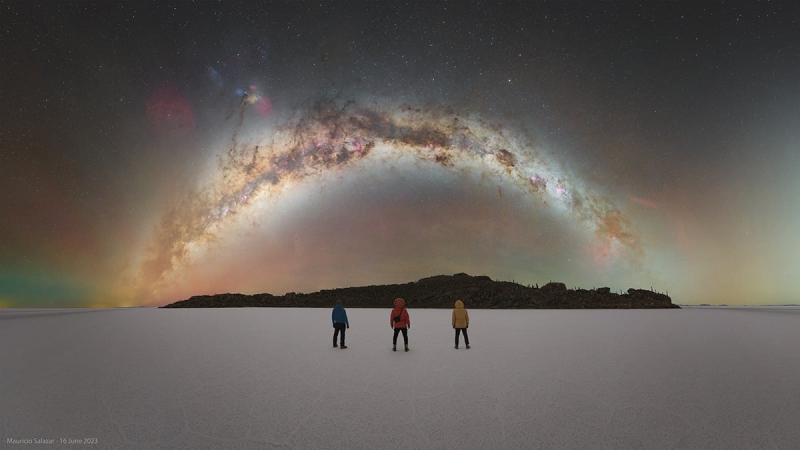Contents
- 1 The interview
- 1.1 When did you start doing astrophotography and what motivated you to take it up?
- 1.2 What equipment do you use and why have you chosen to use them?
- 1.3 Coming to the Southern Hemisphere’s skies, do you feel that those are less explored, especially for wide-field astrophotographers?
- 1.4 What do you feel is special about Southern Hemisphere skies?
- 1.5 What challenges have you come across while photographing from places like Chile or Uruguay?
- 1.6 How do you plan a night’s session, especially from places that have not been explored before?
- 1.7 For somebody visiting the Southern Hemisphere for the first time to photograph the night sky, what would be your top three suggestions?
- 1.8 What would be your three suggestions for somebody who is a beginner astrophotographer?
- 1.9 As an astrophotographer, what do you enjoy the most?
- 2 About the astrophotographer
Southern Hemisphere skies are, well, less explored when compared to that of the Northern Hemisphere. However, it is home to some of the darkest skies in the world, including places in South America and Australia. This provides ample opportunities for sky lovers and astrophotographers to see and capture amazing images from these locations. In this article, we talk to Mauricio Salazar, an astrophotographer from Uruguay who explores the landscapes and skies of the Southern Hemisphere.
The interview
When did you start doing astrophotography and what motivated you to take it up?
I bought my first camera in 2017, and not long after, I had my first attempt at night photography. It was completely unplanned—I simply rested the camera on my car and took a long exposure shot of the night sky. That one image was enough to hook me. I was amazed by how much more the camera could see compared to my own eyes.
From that moment on, I started diving deep into the world of astrophotography, learning all the techniques and fundamentals through online resources. In January 2019, I decided to create an Instagram account solely dedicated to my astrophotography work. I chose the name Astropolo, a reference to the connection between astrophotography and the geographic poles, which are crucial in understanding celestial navigation and the movement of the stars.
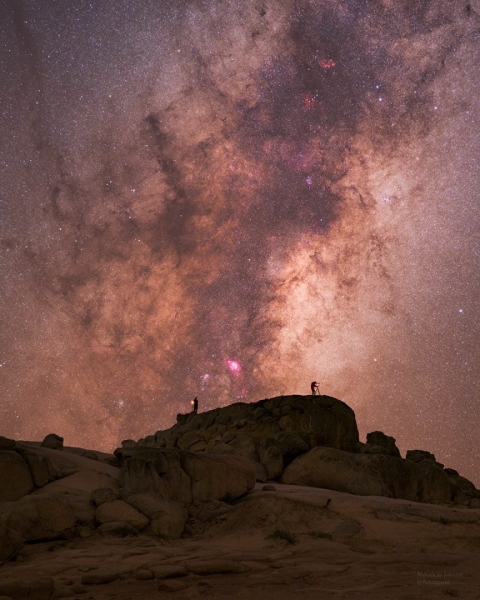
Milky Way Core over ‘Cerro de la Buena Vista’ in Uruguay
What equipment do you use and why have you chosen to use them?
Currently, my main camera is a Nikon Z6II (astromodified), paired with my go-to lenses: Sony 14mm f/1.8 and Sony 20mm f/1.8.
When I first started astrophotography, I used a Sony A6000, and later transitioned to Fujifilm cameras because my father also used Fuji, and we could share lenses. I spent several years capturing the night sky with APS-C cameras before deciding to upgrade to full-frame, and I immediately noticed the improvements in noise performance, low-light capabilities, and overall image quality—something that makes a significant difference in astrophotography.
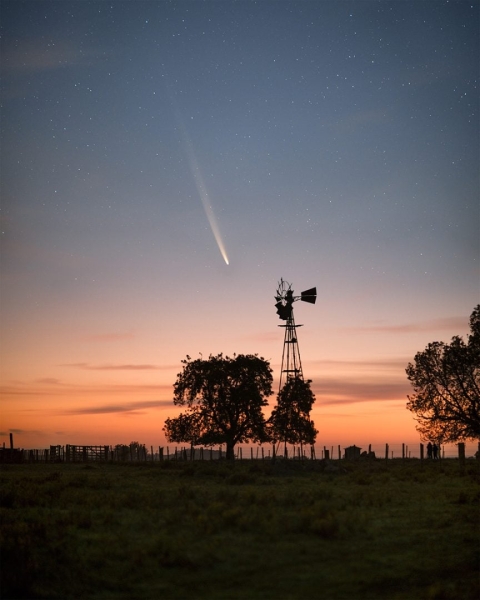
Comet C/2023 A3 Tsuchinshan–ATLAS – on Uruguayan countryside
Coming to the Southern Hemisphere’s skies, do you feel that those are less explored, especially for wide-field astrophotographers?
Yes, I believe astrophotography isn’t as widely practiced or popularized in Southern Hemisphere countries compared to the Northern Hemisphere. However, we are fortunate to have some of the most incredible locations for night photography, such as San Pedro de Atacama in Chile and the Salar de Uyuni in Bolivia—places that many astrophotographers travel to experience under pristine dark skies.
Despite these world-class locations, there is still a lot of potential for astrophotography in the Southern Hemisphere that remains underexplored.

Milky Way on the Total Lunar Eclipse in May 2022 – Train station in Tacuarembo, Uruguay
What do you feel is special about Southern Hemisphere skies?
The biggest advantage we have is that we can see the Galactic Core of the Milky Way for a longer period during the year and at a higher altitude in the sky—sometimes even directly overhead at the zenith. This makes it easier to observe the Milky Way’s structure under dark skies.
Additionally, the Southern Cross constellation, the Carina Nebula, and the Gum Nebula form an incredible region of the sky that is both stunning and unique to the Southern Hemisphere. We also have the Magellanic Clouds, two satellite galaxies that add an extra dimension to wide-field astrophotography compositions.
For anyone who loves capturing the night sky, the Southern Hemisphere is truly special.

The Large Magellanic Cloud and a meteor seen from Dunes in Valizas, Uruguay
What challenges have you come across while photographing from places like Chile or Uruguay?
Each location has its unique challenges:
- Uruguay: We do have dark skies, but the biggest challenge is the unpredictable weather. It’s quite common to plan a night out under the stars on a moonless weekend, only to find that clouds have rolled in, ruining the session.
- San Pedro de Atacama, Chile: The altitude is a big factor. In Uruguay, the highest elevation is around 550 meters, so when I go to 4,000 meters in Atacama, I have to be well-prepared physically. However, the altitude also provides incredibly clear skies, making the challenge well worth it.
Other logistical challenges include dealing with extreme cold, long drives to remote locations, and ensuring all my gear is working properly in harsh environments.
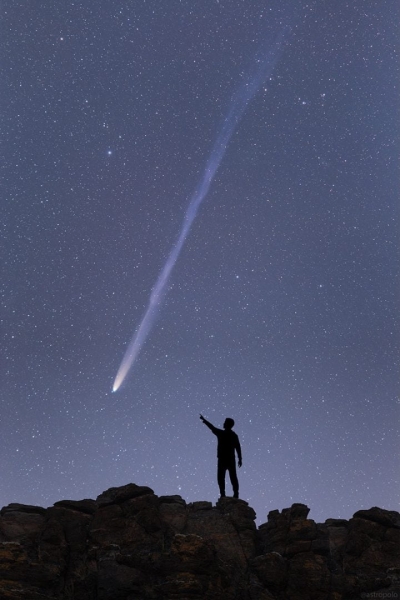
Comet Leonard in December 2021
How do you plan a night’s session, especially from places that have not been explored before?
My planning process involves a combination of apps, maps, and scouting:
- Apps: I rely heavily on PhotoPills and Planit Pro to visualize how the Milky Way and other celestial objects will align with different landscapes.
- Google Maps & Satellite View: Before visiting a location, I search for images taken there and use satellite views to get an idea of the terrain.
- Arriving Early: One of the most important steps is arriving well before sunset. This allows me to scout compositions, find the best angles, and plan my shots before it gets dark.
Good planning ensures that I make the most out of every session.
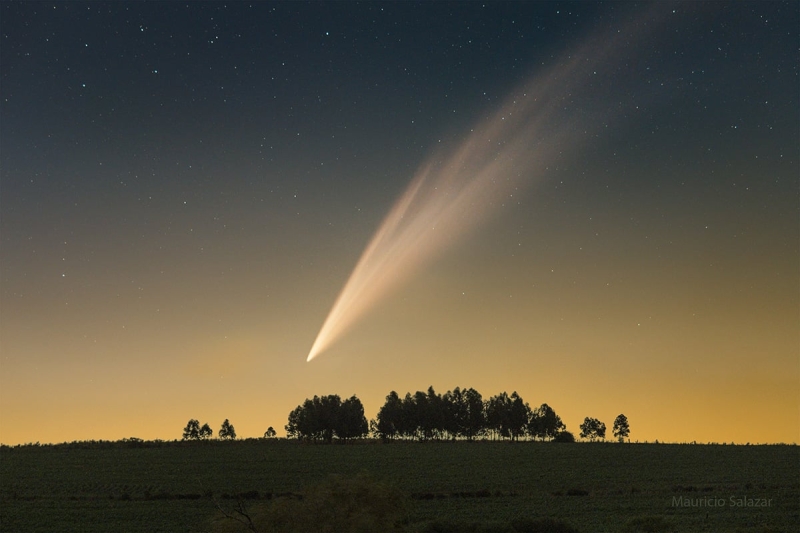
Comet C/2024 G3 over fields – San Jose, Uruguay
For somebody visiting the Southern Hemisphere for the first time to photograph the night sky, what would be your top three suggestions?
- Learn to Track the Southern Celestial Pole – Unlike the Northern Hemisphere, where Polaris makes it easy to find the celestial pole, the Southern Hemisphere lacks a bright pole star. Instead, you’ll need to use the Southern Cross and the Magellanic Clouds as guides. This is crucial for aligning star trackers or composing long-exposure star trails.
- Plan for Winter (May-August) – This is the best season for Milky Way photography, as the Galactic Core is visible almost all night, providing more opportunities to shoot the brightest and most detailed regions of the Milky Way.
- Get Familiar with the Unique Southern Sky Objects – The Magellanic Clouds, the Carina Nebula, Omega Centauri, and the Gum Nebula are some of the best astrophotography targets that are not visible in the Northern Hemisphere. Understanding where and when to capture these objects will help you make the most of your session.

Milky Way over Mount Fitz Roy, El Chalten, Argentina
What would be your three suggestions for somebody who is a beginner astrophotographer?
- Don’t focus too much on gear at first – It’s far more important to learn how to focus at night, what settings to use, and how to compose your shots.
- Practice near home, even if it’s not the darkest location – Knowing your camera well before traveling to dark skies will ensure you make the most of those rare opportunities.
- Be patient and enjoy the experience – Astrophotography is unpredictable. Sometimes the weather doesn’t cooperate, or we make mistakes in capturing the image. It’s important to value the experience and enjoy being under the stars.
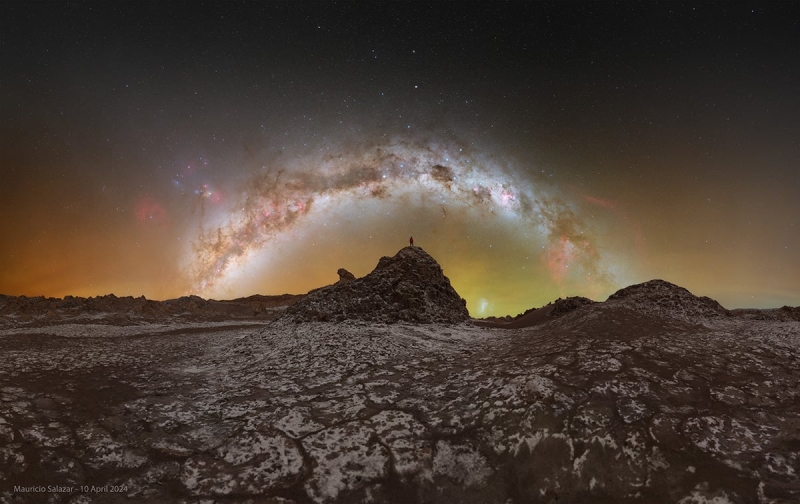
Moon Valley at Night, San Pedro de Atacama, Chile
As an astrophotographer, what do you enjoy the most?
What I enjoy the most is the satisfaction of seeing a vision come to life. When I imagine a photograph, spend hours planning every detail, and everything comes together perfectly during the shoot—it’s an incredible feeling.
As a web programmer, I spend long hours in front of a screen, and astrophotography allows me to balance that by escaping into nature, disconnecting from routine, and immersing myself in the tranquility of the night sky. I also have a strong focus on the technical aspects of astrophotography, always striving to implement the best techniques to achieve the highest image quality in my work.
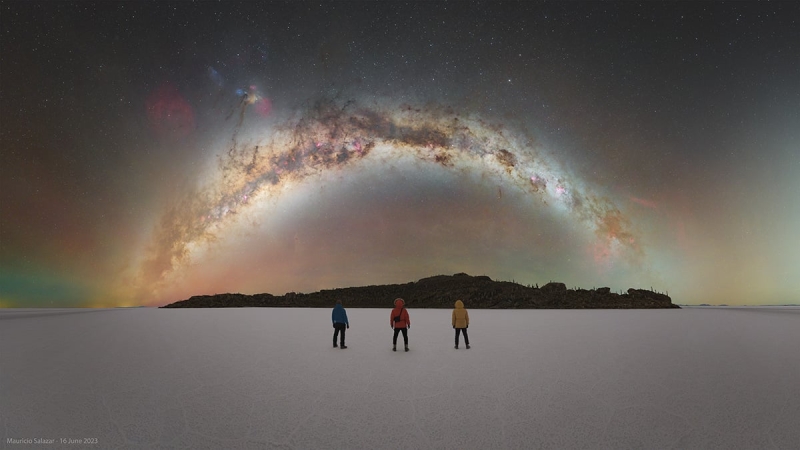
Milky way above Incahuasi Island, Uyuni, Bolivia
About the astrophotographer
Mauricio Salazar is an astrophotographer based in Uruguay, specializing in nightscape photography. His goal is not only to showcase the beauty of the night sky and landscapes but also to raise awareness about the importance of protecting dark skies. Through his images, Mauricio aims to highlight how light pollution threatens our ability to observe the cosmos and inspire others to appreciate and preserve the natural night environment.
Mauricio focuses on capturing South America’s most iconic landscapes under the stars, from the Atacama Desert in Chile to the high-altitude regions of Bolivia, the rugged terrains of Patagonia, and the remote dark-sky locations of Uruguay. Beyond his photography, he conducts in-person workshops in Uruguay and online courses, helping others learn the techniques and planning strategies needed to capture the night sky. Whether through teaching, scouting new locations, or pushing the limits of image processing, he finds joy in the entire process—from imagining a photo to finally capturing and sharing it with the world.
He has won several awards and accolades including multiple NASA APOD, 35 Awards (2019), Photopills “Nightmaster” Award among others. He was also a jury member for the 6th edition of 35 Awards. More of his work can be found on his Instagram feed.
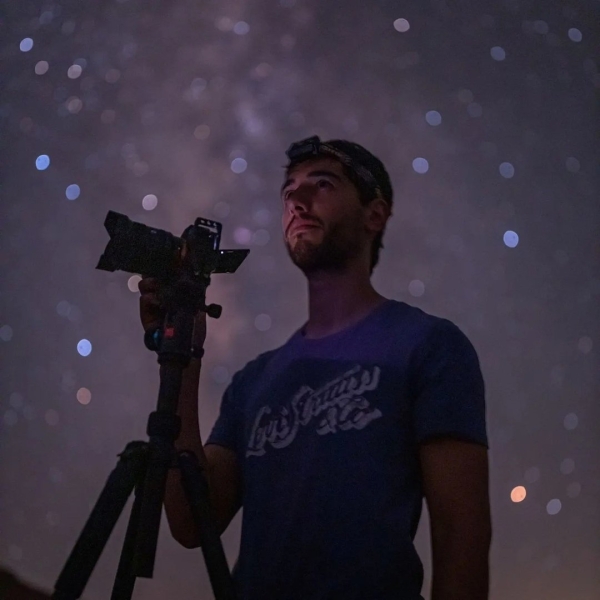
Astrophotographer Mauricio Salazar under a starry night sky
All the images used in the article are by Mauricio Salazar and used with permission.
Clear skies!
